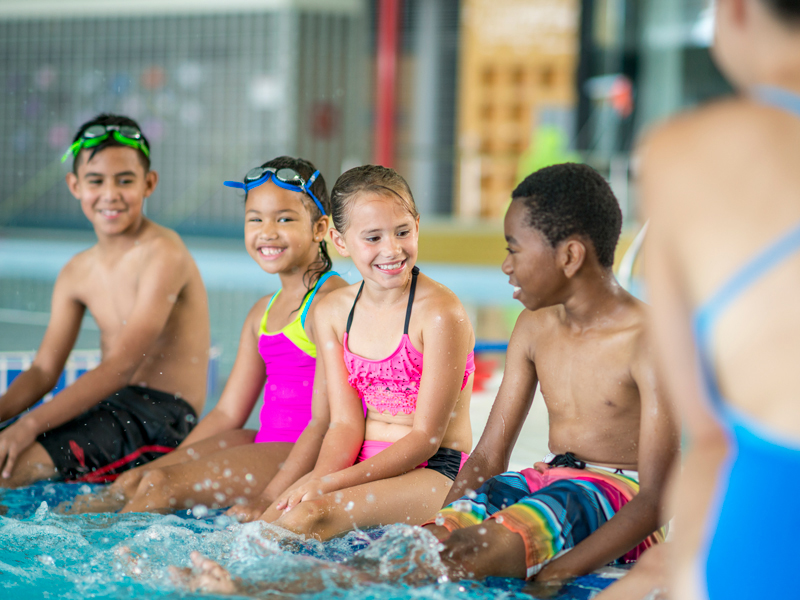Drowning is a serious fear of parents, which is why water safety and prevention is so important.
“The American Red Cross encourages families to make water safety a priority to build confidence in water, for life,” said William D. Ramos, Ph.D., member of the American Red Cross Scientific Advisory Council. “Preventing unsupervised access to water, providing constant, active adult supervision in and around the water, and knowing how to swim are critical layers of protection to help prevent drowning.”
Being in and around water — from the bathtub and pool to lakes, rivers and oceans — can be safe if parents and children follow these tips.
Swimming pool water safety
- Supervise children of all ages when in a swimming pool. Supervising adults should know how to swim, preferably CPR certified and avoid distractions such as cell phones.
- Any child or inexperienced swimmer should be within an arm’s reach of the supervising adult when swimming.
- Never allow children to run around a pool, and avoid riding toys near the poolside.
- Pools should have fences that surround all four sides and are at least four feet tall. The back of the house should not serve as a fourth side; however, if it does, install an alarm on the exit door to the yard and pool. The fence gate should open out from the pool, self-close and latch. The latch should be out of reach of young children to ensure safety.
- Always have rescue equipment and a functioning telephone nearby the pool.
- Inflatable swimming aids, such as arm floaties, are not recommended and do not substitute for appropriately fitting, U.S. Coast Guard approved life jackets.
- Suction from pool and spa drains can be dangerous. Pool owners should ensure drains are functioning correctly, regularly updated and compliant with the Pool and Spa Safety Act.
For more information: Visit online at poolsafely.gov.
Swimming lessons
Children should learn how to swim. Children ages one to four may be at a lower risk of drowning after having formal swimming lessons. But, there is no data indicating swimming lessons prevent drowning in infants under age one. The American Academy of Pediatrics supports swimming lessons for children age one to four if the child is personally ready to learn how to swim. Before having your child start swimming lessons, consider your child’s:
- Comfort level with water
- Emotional maturity and development
- Frequency of exposure to water
- Personal health concerns
- Physical abilities and strength
Swimwear colors
It probably wouldn’t come to mind immediately for most parents, but the color of your child’s swimsuit can be a factor in how safe they are at the beach or the pool.
Water safety experts recommend bright, contrasting colors that stand out in the water. Tests have demonstrated that neon orange and pink are most visible underwater. There is some variance on visibility in pools vs. lakes but overall, the neon yellow, pink, lime green and orange were most visible in both environments.
Darker colors and pastels are less visible based on testing done by Alive Solutions.
Open water safety
- Children should never swim alone. Even good swimmers need buddies.
- Designate a water watcher – someone who is attentive and tuned into the children swimming for 10-15 minutes before a new person takes on the water watcher role. This makes sure children are closely supervised and adults don’t just assume everyone is watching.
- Ocean swimming should only be allowed when a lifeguard is on duty.
- Just like in swimming pools, less experienced swimmers require a parent to be no more than an arm’s length away, also called “touch supervision.”
- Children should never dive into water unless there is certainty of the depth beforehand. The underwater area should also be cleared of hazards. Serious spinal cord injuries, brain damage and death can occur when diving into shallow water.
- Children should never swim in canals or other fast moving water. Teach children about currents and rip tides. If caught in a tide, swim parallel to the shore until able to escape the current, then swim safely to shore.
Boating safety
- Children, inexperienced swimmers, and all boaters should wear U.S. Coast Guard-approved life jackets.
- Water wings, blow-up toys and rafts are fun for playing but should never be used in place of a securely fitting life vest.
- To prevent boating dangers, all adult and adolescent drivers and passengers should avoid using alcohol, illicit drugs and certain prescription medicines.
Warning signs of drowning
Recognize the signs of a swimmer in trouble and shout for help, the American Red Cross advises. A swimming child needs immediate help if they:
- Appear to climb an invisible ladder
- Attempt to roll over
- Are breathing hard or fast
- Are closing eyes or have hair covering their eyes
- Gasp for air
- Have their head lower in the water or their mouth at water level
- Are vertical in water but unable to move or tread water
- Look spaced out or unable to focus
- Try to swim but aren’t making forward progress
What to do in a drowning emergency
Follow American Red Cross guidelines:
- If a child is missing, check the water first: Seconds count in preventing death or disability!
- Alert the lifeguard, if one is present.
- Rescue and remove the person from the water (without putting yourself in danger).
- Ask someone to call emergency medical services at 911. If you’re alone, give 2 minutes of care, then call EMS.
- Begin rescue breathing and CPR. Know how to perform child and baby CPR.
- Use an AED if available and transfer care to advanced life support.
Read more
- How to handle swimmer’s ear this summer
- Swimming lessons benefit people of all ages
- Adaptive Aquatics welcomes kids with disabilities into water
…
Posted In Children's, Health Information, Healthy Living, Parenting
